How To Prevent Kite Injuries
Kitesurfing is for many kiters not just a hobby, but also a way to express their feelings and to feel alive. To master the two elements water and wind at the same time is truly amazing! I´ve been kiteboarding for many years and my worst nightmare is being forced to quit
kitesurfing due to an injury. It´s like someone would take a part of my soul.
However, you cannot ignore the fact that kitesurfing isn’t just a risky activity, but also stressful for your body’s joints and muscles. I consider myself pretty young, I´m 33 years old and I´ve been kitesurfing for 3 years. I´m strong and well trained, but still I feel that all the stress that kitesurfing puts on my body is hurting my muscles and joints. Like many other I like to jump sky high and to learn new tricks. To crash in the water now and then is inevitable as well as land hard after you pulled that trick that didn’t quite go as you planned. During my kiteboarding career I have had back problems, pain in my elbows and knees. Luckily I´ve been able to recover from all problems through rest and rehabilitation, but it often feels like it´s just a matter of time before I´ll get so seriously injured that I’ll have to stay out of the water for an indefinite period and I don´t want that to happen.
Stretching and warming up before I go out in the water has been out of question, until recently. All issues with pain here and there plus the fact that my body is exposed to harmful stress has forced me to do certain exercises as well as stretching and warming up before a kite session. Nowadays I listen to my body and I do what I can to prevent injuries. I believe that most kiters are suffering from pain in some body parts and therefor I put together a guide on how you can treat and make your weak parts stronger and minimize the risk for injuries.
Stretching – what´s the point?
Most people know that stretching is good before and after you exercise, but many don’t understand why. Regular stretching lengthens the muscle fibers and with time also creates flexibility. When you deeply and slowly stretch a group of muscles you are also helping to bring a good flow of oxygenated blood to the area. This increased flow of blood and oxygen has another important function for the billions of muscle cells, namely to discharge their waste products; primarily lactic acid. Lactic acid build-up is the reason that the muscle fatigues and, in large quantities, it can form trigger points or painful “knots” in the muscle body. That´s why it´s equally important to stretch before and after your kite session or indeed any other physical activity. Neurologically a good stretch is like a “reset” button. We are “reminding” the cerebellum (the part of the brain that constantly monitors muscle tension) what the normal resting tension of the muscle should be to avoid chronic tightness. A flexible muscle is much stronger and more resilient than a rigid one.
PFS stretching and the antagonist squeeze: We always get a deeper stretch after a short, mild contraction of the same muscle. It´s a neurological “trick” called Post Facilitation Stretching. Another simple trick is to actively contract the antagonist or “opposite” muscle group. For example, when stretching the hamstrings seated on the ground you should contract the quadriceps, which forces the leg to be straight. The body cannot contract both opposing groups of muscles at the same time. So contracting the quads effectively “turns off” the hamstrings and allows you to stretch deeper.
How long? A good “holding time” for each stretch is 5 deep breaths. Each time you breath out, emptying your lungs, you should be taking the stretch a little bit deeper. Then hold that new position while inhaling and repeat the process. Never “bounce” a stretch. When you do that you are actually initiating a natural protective reflex that causes the muscle fibers to tighten up even more!
Knees – how to keep them in good condition
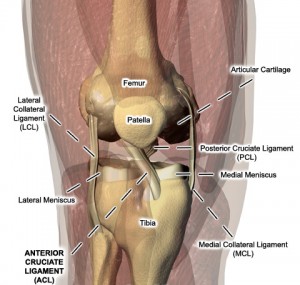 Undoubtedly the most devastating injury for a kiteboarder is to the knees. Complete blowout of the collateral and/or cruciate ligaments with damage to the meniscus is not unheard of in the kite world. Normally such severe damage results from having one foot out of the bindings or from landing a powered up jump low and fast. However, chronic inflammation and pain with clicking and snapping sensations and a feeling of weakness is what most kitesurfers suffer. This is so frustrating for many because it’s a problem that comes and goes and can’t be nailed down with a single diagnosis. Here is what you should do in order to keep your knees in good shape.
Undoubtedly the most devastating injury for a kiteboarder is to the knees. Complete blowout of the collateral and/or cruciate ligaments with damage to the meniscus is not unheard of in the kite world. Normally such severe damage results from having one foot out of the bindings or from landing a powered up jump low and fast. However, chronic inflammation and pain with clicking and snapping sensations and a feeling of weakness is what most kitesurfers suffer. This is so frustrating for many because it’s a problem that comes and goes and can’t be nailed down with a single diagnosis. Here is what you should do in order to keep your knees in good shape.
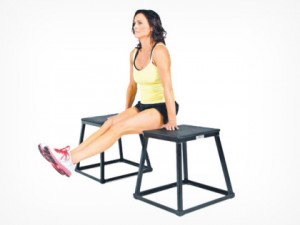 Proper warm-up and “lubrication”. This is essential to prepare the knees for the stress that is put on them during a kite session. It´s accomplished by taking the articulation through full range of motion (ROM) in a slow, controlled manner supporting body weight if possible with a chair on each side or “hanging” your weight from a tree or whatever you can find in the surroundings around you.
Proper warm-up and “lubrication”. This is essential to prepare the knees for the stress that is put on them during a kite session. It´s accomplished by taking the articulation through full range of motion (ROM) in a slow, controlled manner supporting body weight if possible with a chair on each side or “hanging” your weight from a tree or whatever you can find in the surroundings around you.
Keep your muscles in balance. Many orthopedics and chiropractors recognize that imbalances in the quadriceps muscle group are often part of the chronic knee pain and swelling. In many athletes, the lateral or “outside” muscle of the quads is tighter than the medial part. This tends to pull the kneecap a bit diagonal as we flex and extend the joint and, with time, causes inflammation under the patella. Stretching the lateral can help to alleviate this problem so that the patella “track” properly.
In the standing version, try touching your heel to the opposite buttock to feel the stretch more on the lateral side. Once in the position shown in the picture, slowly bend the supporting leg and lower your body while pushing your hip area forward. Try to make you’re your body straight from chest to kneecap.
On the ground, don’t bend your back too much. Keep the heel touching your butt and push the hip forwards.
Try position yourself in the shape of a C-kite, pushing your hips out gives a great stretch to the lateral muscles of the thigh.
Adjust your bindings so that you have some space between your feet and footpads. Try to make small adjustment of the bindings until you achieve a position where you feel the least tension in your knees while edging hard or when you are twisting your body when riding upwind. Remember that the arch of your foot is the only shock absorber for your entire body! Bindings and footpads with arch support and heel wedges may be a great investment if set up correctly for your feet and riding style. At the first sign of irritation in the knee joints you should stretch, cool down your knees with ice or cold packs, and think about making changes in your stance.
Ice vs. Heat. It´s generally accepted that a recent injury can be cooled down with ice the first 48 hours. A sudden strain or damage to an articulation (twisted ankles, banged or sprained knees, wrists, fingers, shoulders) should be iced as much as possible the first two days, 15 minutes of ice followed by 45 minutes of rest before applying the ice again. The key is to keep inflammation to a minimum because a sudden swelling will cause more pain and damage even more tissue. Hard exercise and chronic contractions of the muscles between your shoulder blades (Rhomboid and Levator Scapula muscles) can give sore muscles in your back. This is treated with moist and heat rather than ice. If you’re unsure whether to use ice or heat, try alternating the two methods to see which one that gives the most immediate and long-term (day after) relief. A bag of frozen peas or corn is a great alternative to a cold gel pack. Put a damp towel in the micro wave for 2 minutes to create a decent hot moist pack.
Abdominals
A strong core is crucial to be able to be out in the water for hours. Every jump, tack and every second of hard edging put load on our upper body which we mainly support with our abs and muscles in the lower back. Many beginners have to take frequent breaks because all the walking with the powered kite is some serious training for your abs. Remember though that even a solid six-pack easily can get damaged from chronically contracted muscles.
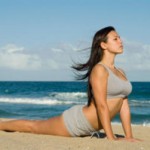 Yoga is not only good for peace and mind,
Yoga is not only good for peace and mind,  but also to make your body flexible in general. The “Cobra” gives your abs a good stretch and can be done everywhere. But the absolutely best way to stretch out the internal and external oblique’s as well as the transverse abdominal muscle is done with a therapy ball a.k.a. “bobath ball”. Not only is this ball superb for stretching, but also a great tool for all kind of exercises for your entire body. A cheap investment that you’ll not regret!
but also to make your body flexible in general. The “Cobra” gives your abs a good stretch and can be done everywhere. But the absolutely best way to stretch out the internal and external oblique’s as well as the transverse abdominal muscle is done with a therapy ball a.k.a. “bobath ball”. Not only is this ball superb for stretching, but also a great tool for all kind of exercises for your entire body. A cheap investment that you’ll not regret!
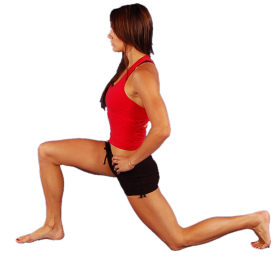 Extensive kiting can easily
Extensive kiting can easily 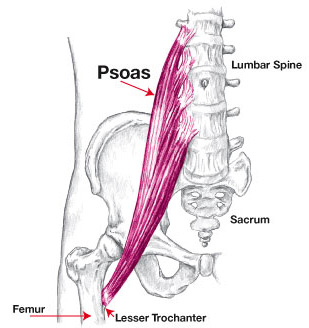 fatigue the abdominals. When this happen, the primary hip flexors, also known as the Psoas muscles, start to substitute your abs. Many kitesurfers have super contracted Psoas muscles from edging like freaks for hours-long sessions. On top of this they often have a job where they pretty much just sit on their ass in front of a computer from morning till late afternoon. And it’s not unusual that they spend the evenings sitting in the car and then in the sofa back home. All this sitting put the Psoas muscle in its shortened position. Problems then arise in the lower back because the Psoas connects directly to the lumbar vertebra (see picture) and can be causing pelvic imbalance with every step you take!
fatigue the abdominals. When this happen, the primary hip flexors, also known as the Psoas muscles, start to substitute your abs. Many kitesurfers have super contracted Psoas muscles from edging like freaks for hours-long sessions. On top of this they often have a job where they pretty much just sit on their ass in front of a computer from morning till late afternoon. And it’s not unusual that they spend the evenings sitting in the car and then in the sofa back home. All this sitting put the Psoas muscle in its shortened position. Problems then arise in the lower back because the Psoas connects directly to the lumbar vertebra (see picture) and can be causing pelvic imbalance with every step you take!
Note! Sharp pain in the lower abs that gets even worse from coughing or straining can be signs of an inguinal hernia. Professional help should be consulted in this case.
Lower Back Pain
Many kiters blame their lower back problems on the harness. Choice of harness is for sure very important. You would like a harness that is ergonomic and that gives support and stability to your core. Sometimes back problems arise from an improperly adjusted harness. Experiment by slightly changing the tension on the straps for a couple of sessions to find out if your back problem might arise from the harness.
However, the most common reason to lower back pain is lack in flexibility. 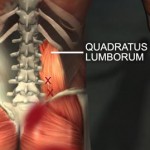 Just as you take care of your beloved kite, your car and your house, this is something you also should apply to your Quadratus Lumborum muscles, since this could save you lots of problem later on.
Just as you take care of your beloved kite, your car and your house, this is something you also should apply to your Quadratus Lumborum muscles, since this could save you lots of problem later on.
Almost every kitesurfer who consult physiotherapists to overcome his back problems have severe muscle contraction in the gluteus, i.e. the butt muscles. The butt muscles are some of the strongest postural muscles in the body. Their primarily function is to extend the legs. When they are constantly tense they cause a constant painful pressure in the articulations of the lower back. For patients with shortened gluteus muscles the immediate prescription is abdominal toning and gluteal stretching. Kitesurfers normally have great abs so that why we only have to work on the flexibility for the gluteus. Two great exercises for stretching your gluteus.
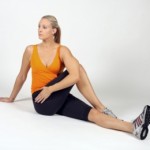
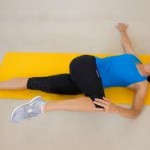 1. Sitting or lying position. Bring your knee towards the opposite shoulder. Keep your upper body straight up in the sitting variant. Don’t bend and fall forward with your upper body.
1. Sitting or lying position. Bring your knee towards the opposite shoulder. Keep your upper body straight up in the sitting variant. Don’t bend and fall forward with your upper body.
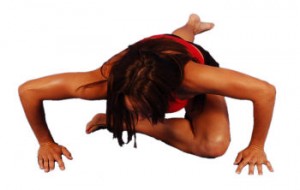 2. The deepest stretch for the gluteus is done with your face down as shown in the picture here to the right. Start in a pushup position and bring one leg forward underneath you. Extend the other leg and bend at the hips by rotating your upper body slightly. If you had to choose just one stretching exercise for your lower back, this is the one!
2. The deepest stretch for the gluteus is done with your face down as shown in the picture here to the right. Start in a pushup position and bring one leg forward underneath you. Extend the other leg and bend at the hips by rotating your upper body slightly. If you had to choose just one stretching exercise for your lower back, this is the one!
Kiters Elbow
Kiters elbow a.k.a. “sine wave elbow”. Sine wave arises from when we are flying the kite in figures of eight in an attempt to stay upwind. Flying your kite up and down can quickly cause pain in your elbows, so avoid kitesurfing when the wind is light or take a bigger kite so that you’re fully powered.
Repetitive motions as well as tightly gripping the bar for a long time without rest increases the risk of causing inflammation to the common flexor or extensor tendons on the forearm.
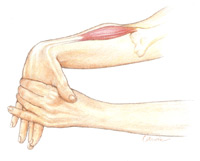
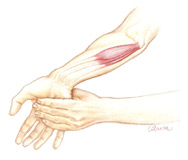 The key to treat and prevent a kiters elbow is stretching with a completely straight arm. With your arm stretched out, grab the top of your hand and bend it inward. Then rotate (supinate) your arm and grab the palm and fingers, bend inwards again.
The key to treat and prevent a kiters elbow is stretching with a completely straight arm. With your arm stretched out, grab the top of your hand and bend it inward. Then rotate (supinate) your arm and grab the palm and fingers, bend inwards again.
Furthermore, 15 minutes of icing directly on the painful area at night before bed will help to rapidly decrease an ongoing inflammation. Just don’t forget to stretch before you put on ice.
Neck Pain
A nasty case of torticollis (stiff neck) can put you out of order for several days. Painkillers and muscle relaxants can for sure help a bit, but riding upwind as well as overlooking your shoulder to spot the gust or the incoming rider can be horrible painful.
A week later when the pain is gone you still have a reduced ROM and you are more likely to get a spastic contraction in the same muscle again the next time you fail a landing, sneeze with your head turned etc.
A good physiotherapist can help you to work out old scar tissue in the neck and upper back muscles and develop strength again; but rehabilitation can often be a long, boring and painful process. Why not prevent this vicious circle with two simple exercises?
 1. While sitting or standing, “fix” one shoulder down and gently pull the head diagonally in the opposite direction. This exercise is good for stretching out the Levator Scapula and the upper Trapezius muscles.
1. While sitting or standing, “fix” one shoulder down and gently pull the head diagonally in the opposite direction. This exercise is good for stretching out the Levator Scapula and the upper Trapezius muscles.
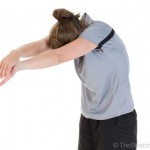 2. Office workers often complain about a deep nagging
2. Office workers often complain about a deep nagging 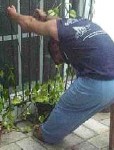 ache in the muscles between the shoulder blades, this can be fixed with this exercise. “Release” the muscles in your back, let the head fall forward between your crossed arms. Take deep breaths and try to relax and separate the shoulder blades from your spine. For an even deeper stretch, grab on to something like in the picture to the right.
ache in the muscles between the shoulder blades, this can be fixed with this exercise. “Release” the muscles in your back, let the head fall forward between your crossed arms. Take deep breaths and try to relax and separate the shoulder blades from your spine. For an even deeper stretch, grab on to something like in the picture to the right.
Shoulder Injuries
Shoulder injuries are just as difficult to treat as knee injuries and  usually with a long recovery time. Unhooked jumps, such as raileys and monkey airs can put tremendous strain on the small muscles of the rotator cuff. Any therapist would grimace of pity if they knew how much power that was tied to the other end of those lines in the famous picture of Luis Peraltas in the middle of a handlepass.
usually with a long recovery time. Unhooked jumps, such as raileys and monkey airs can put tremendous strain on the small muscles of the rotator cuff. Any therapist would grimace of pity if they knew how much power that was tied to the other end of those lines in the famous picture of Luis Peraltas in the middle of a handlepass.
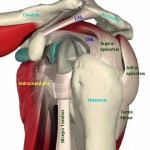 Rehab of the rotator cuff is a delicate topic that would require another entire book! So let’s not go into details but stick to how we can prevent injuries. The most commonly damaged muscle in the rotator cuff is the small external rotator muscles seen in the picture.
Rehab of the rotator cuff is a delicate topic that would require another entire book! So let’s not go into details but stick to how we can prevent injuries. The most commonly damaged muscle in the rotator cuff is the small external rotator muscles seen in the picture.
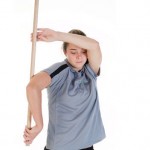 A good way to keep the rotator cuff in shape is
A good way to keep the rotator cuff in shape is 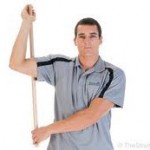 to do these two broomstick stretches that are adapted from the Major League baseball warm-up routine. The left photo shows a deep stretch of the external rotator of the right arm. The right picture shows an exercise where you stretch the fibers in the Pectoralis and Subscapular muscles (internal rotators of the arm). Be careful when doing this exercise since the leverage from the stick really creates a powerful stretch!
to do these two broomstick stretches that are adapted from the Major League baseball warm-up routine. The left photo shows a deep stretch of the external rotator of the right arm. The right picture shows an exercise where you stretch the fibers in the Pectoralis and Subscapular muscles (internal rotators of the arm). Be careful when doing this exercise since the leverage from the stick really creates a powerful stretch!
 Chest muscles are not exposed to any direct stress during kitesurfing, but included here is a last stretch that provides a nice pull for generating flexibility in the pectoral and deltoid (shoulders) muscles. Push your arms up and backwards to feel the stretch. You can always grab on to something with your hands and bend your knees to get better leverage.
Chest muscles are not exposed to any direct stress during kitesurfing, but included here is a last stretch that provides a nice pull for generating flexibility in the pectoral and deltoid (shoulders) muscles. Push your arms up and backwards to feel the stretch. You can always grab on to something with your hands and bend your knees to get better leverage.
Legs
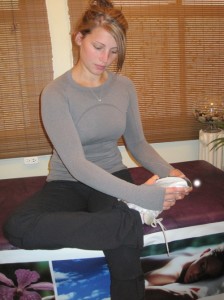 If your straps or boots are set up correctly and if you never ever had to use a big board in strong wind and choppy water then you might be lucky to never have suffered from “shin splints” while kiting. Symptoms on this issue is a sudden weakness in your Tibialis Anterior muscle (the one that keeps your toes up) and serious stabbing pain even during your softest and perfect landings.
If your straps or boots are set up correctly and if you never ever had to use a big board in strong wind and choppy water then you might be lucky to never have suffered from “shin splints” while kiting. Symptoms on this issue is a sudden weakness in your Tibialis Anterior muscle (the one that keeps your toes up) and serious stabbing pain even during your softest and perfect landings.
You can avoid this problem by keeping your footstraps/bindings perfectly adjusted, coming in for your small board when the wind picks up, and stretching these muscles before and after your kite sessions.
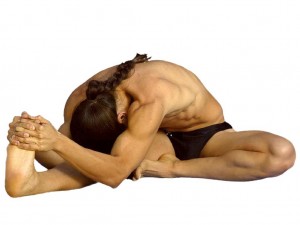 Of all muscles groups the Hamstrings (Biceps Femoris) are probably the most stretched muscle of people in general. A typical warm up for ordinary people consists of jogging at the place, some “X-jumps” and maybe some shadow boxing before bending the waist in an attempt to reach their toes with their hands. The intention is good, but a much better way to stretch your hamstrings is by sitting down and slowly stretch these muscles and by using a towel if you can’t reach your toes. Keep the quadriceps muscle contracted so that your knee is completely straight.
Of all muscles groups the Hamstrings (Biceps Femoris) are probably the most stretched muscle of people in general. A typical warm up for ordinary people consists of jogging at the place, some “X-jumps” and maybe some shadow boxing before bending the waist in an attempt to reach their toes with their hands. The intention is good, but a much better way to stretch your hamstrings is by sitting down and slowly stretch these muscles and by using a towel if you can’t reach your toes. Keep the quadriceps muscle contracted so that your knee is completely straight.
To take this stretching exercise one step further, push the toes away, contracting the calves for 2 seconds, then relax, squeeze the antagonist muscles (Quadriceps in this case), exhale and stretch even deeper.
The calves can easily be stretched by using the curb of the street, some stairs, a stone or whatever that is a big higher than the ground. This is a great way to let your muscles get perfusion of oxygenated blood, bringing new life to tired legs.
Conclusion
Kite smart. Take one day of if you feel some pain. To miss one day of kitesurfing is not everything. To face the future without having the possibility to kitesurf is for many not an option. So listen to your body, stretch and keep your muscles strong. Kitesurfing is too great to end sitting on the beach injured, just because you were too lazy to warm up and stretch.


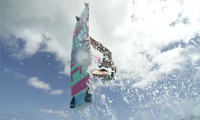
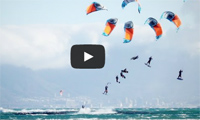

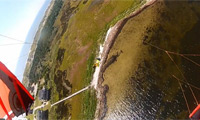

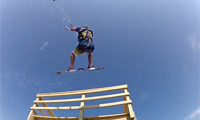
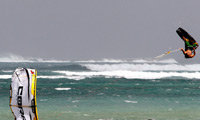
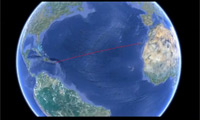




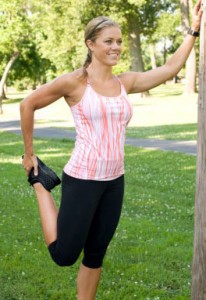
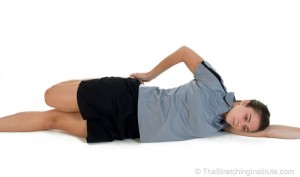
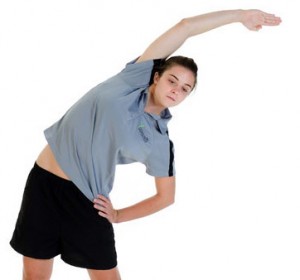
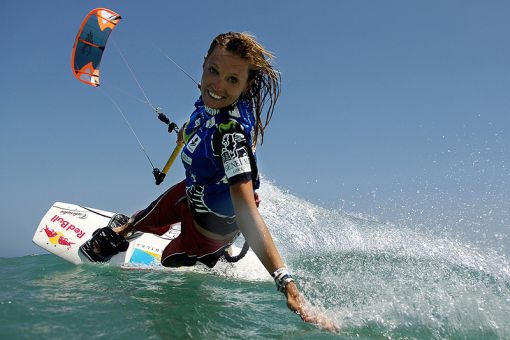
3 Responses
Cool :0) Some good stuff in this article :0) You can also check out http://www.KiteboardingExercises.com for rehab and training programs
Posted on August 11th, 2012 at 6:04 pm
Great article. I feel exactly the same way; I put my body under a lot of stress from kiting, and occasionally experience irritation in my knees and elbows… I had back pain in the past, and used to blame my harness. This has since diminished after taking up yoga and stretching my tight hip flexors and hamstrings. Now I’m looking for some knee and elbow stretches targeted toward kitesurfers to ensure I don’t get injured.
Posted on December 10th, 2012 at 11:49 am
Excellent resource, clearly explained. Thank you. .
Posted on November 5th, 2015 at 1:35 pm
Add A Comment
You must be logged in to post a comment.